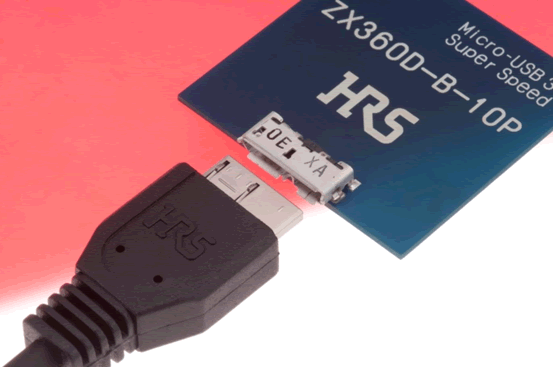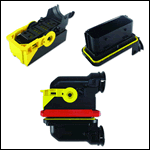How to Specify High-Transmission I/O Connectors
Today’s requirements for input/output connectors demand smaller size and faster data transmission. Hirose advises designers on how to specify high-transmission I/O connectors by looking at a multitude of requirements and trade-offs.
An I/O connector is an interconnect that joins a circuit from inside to the outside of electronic equipment. I/O interconnects are used to connect data, audio, video, power, telecommunication circuits, and more. Many I/O connectors conform to industry-standard specifications, so that regardless of the manufacturer, the connectors can inter-mate with each other. Some examples of commonly used I/O connectors for data transmission are USB, HDMI, and RJ45 – Ethernet, RJ11– phone, CAT6, PCMCIA, S-Video, SERIAL RS-232-C, SCSI, and FireWire.

Hirose’s ZX360 Micro USB 3.0 connector – This 10-pin series includes additional pins for USB 2.0 compatibility and USB locking features for simple horizontal mating with no additional lock security.
Today’s requirements for input/output connectors demand smaller size and faster data transmission. Designers must consider a multitude of requirements and trade-offs when choosing a high-speed I/O solution. If an application requires high data transmission, then higher functionality per square inch can be the deciding factor for the choice of a product. Connector manufacturers strive to provide I/O products to meet those changing requirements. The demand for small devices that are capable of high speeds is readily apparent in applications such as mobile communication devices, cameras, tablets/PCs, hard drives, wearables, Internet of Things (IoT), automotive applications, portable medical devices, and more.
Many I/O high-speed connectors adhere to a system built around a standard messaging protocol that defines the mechanical and electrical interface.
Connector Type
The first question design engineers should ask when specifying an I/O connector is what type of connector will best suit the application. The most appropriate connector type to specify depends on data rate, available space, configuration of the device, the industry standard for the equipment, and other factors. Choosing the right connector type is the first step in designing your product.
Optimizing Size and Speed
Where many applications require small size, it is important to consider design limitations. Decreasing the physical size of a connector can cause changes in the geometry of the electrical conductor, which can cause perturbations and alter the signal integrity. In addition, the production of heat must be considered, especially when using a very small component.
Moreover, as speeds increase, rise times decrease, and the signal traveling through interconnects can be significantly affected. Factors such as return loss, crosstalk, attenuation, and electromagnetic interference can influence which connector will provide the optimal solution for a given application. Signal integrity (SI) is one of the most important high-speed system design concerns.
Data Type
Another important factor in your choice is the type and quantity of data that will be transmitted. Types of data such as audio, streaming audio/video, or large packs of data will have a bearing on which product is most suitable.
Ease of use
The user-friendliness of the product can be important, especially if the application is consumer-based, or the connector will be plugged/unplugged multiple times. If this process is too time-consuming or complex on a device with high use, it may be better to select a connector with a simpler locking operation.
Durability
Ruggedness and contact wear may be key factors in your connector selection process. A connector with a high mating cycle would be needed for a device such as a phone or laptop. Contact wear can be affected by contact plating material as well as structure. For example, contacts with thicker gold plating can provide higher mating cycles than those with gold flash plating.
Locking Mechanism
Depending on how the end product is used in the field, a rugged locking mechanism may be required. Applications that involve handling, dropping, or frequent vibrations may necessitate secure locking mechanisms. Some customers require an easy-to-use snap-in lock with quick release, whereas customers with applications such as industrial machinery may require a vibration-resistant or high pull-force screw-in type lock. Other applications demand connectors with quick or easy mating/unmating that will disconnect in the event that someone trips over or becomes entangled in the cable.
Contact Configuration and Assembly
It is also a good idea to study the termination features of the connector, including whether it uses crimping, soldering, IDC, etc., and the cabling that is most suitable for the cable-connector interface within the application. Remember the cable will have to meet the requirements of attenuation, impedance, current flow, and any type of handling that will occur.
Optimizing Performance, Size, and Cost
The challenge to optimize size and performance is often interwoven with cost. For example, the cost to manufacture high-performance miniaturized connectors can be higher than that of comparable larger connectors, so the designer must navigate this trade-off accordingly.
Another aspect of performance optimization is quality in manufacturing. If the product is poorly manufactured with high fallout or deformation, the long-term costs may be higher due to repair/replacement costs, defective parts, and faulty systems. Selecting a product with high-quality manufacturing that could cost a little more up front could ultimately save time and costs in the long run.
Additional considerations are assembly time and cost and the importance of shielded verses unshielded configurations.
Repair and Replacement
Aside from initial assembly and installation, determine if the application will allow repair or replacement of the connector. Take into account the ability of the technician to perform the repairs, such as whether repair will occur on-site or at a service depot, the ease of terminating the contacts, as well as the cost and availability of parts.
A system engineer who is designing a product that requires high-speed I/O connectivity should consult with the connector supplier’s application specialist early in the process. This will help to accelerate the decision-making process for selecting the best solution.





